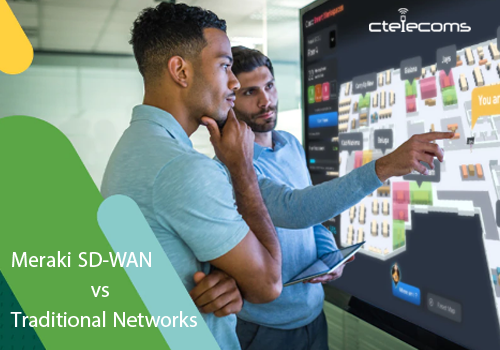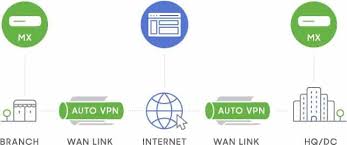

2023/03/22 Meraki Networking Solutions 1269 visit(s) 3 min to read
Ctelecoms

SD-WAN is a modern and advanced form of connectivity that has replaced the traditional MPLS technology. It allows customers to have greater control over their network by assigning priority to important business data and utilizing multiple transport option. This makes the management of WAN more straightforward and freer from the limitations of transport layers.
The Cisco Meraki security devices have integrated SD-WAN capabilities that allow administrators to enhance network stability and improve bandwidth effectiveness.
MPLS can have steep bandwidth costs, while SD-WAN protects your network from vulnerabilities that MPLS cannot. The short answer is that SD-WAN offers better visibility, availability, enhanced performance, and more freedom of action. It's why the industry has seen interest in SD-WAN rising over the past few years. Nowadays, thousands of companies around the world are now adopting Meraki SD-WAN primarily and it is expected for this number to be increased exponentially soon.
Todays, Thousands of companies around the world are now adopting Meraki SD-WAN primarily and it is expected for this number to be increased exponentially soon.
1- Traditional WAN:
A traditional WAN network is made up of completely hardware-based network devices that primarily use Multi-Protocol Label Switching (MPLS) for efficient and reliable network traffic flow. The network involves multiple hardware devices and proprietary circuits for routing IP services to clients. Managing the network is a challenge for IT teams as it includes multiple layers of underlying hardware. Scaling the traditional network is difficult and requires proper advanced planning and the right network infrastructure. The traditional WAN connects multiple Local Area Networks (LANs) and Virtual Private Networks (VPNs) and is limited to enterprise, branch, and data center, but security issues and management difficulties are the major problems in traditional WAN nowadays.
2- Software Defined Wide Area Network (SD-WAN):
SD-WAN is a software-defined approach to manage a Wide Area Network. The software controls all aspects of the network, from connectivity to management and service provisioning. It's a virtual network approach that combines traditional WAN technologies such as MPLS and broadband connections. SD-WAN is ideal for global enterprises as it offers better and more secure application performance, optimized cloud connectivity, and simplified management.

One of the factors contributing to the widespread adoption of SD-WAN is the increasing trend of remote work and cloud utilization. With SD-WAN, remote employees can access enterprise applications and data from anywhere with improved security and reliability, resulting in a better user experience.
Meraki SD-WAN gives enterprises the capability to categorize data based on importance and select the quickest, most reliable, and cost-effective path available, ensuring a smooth and efficient network operation.
|
|
SD WAN |
TRADITIONAL WAN |
|
1 |
Software Defined WAN provides a software defined approach of managing Wide Area Network. |
Traditional WAN provides a conventional approach of managing Wide Area Network. |
|
2 |
It provides a better flexibility in WAN management. |
It fails to provide a better flexibility in WAN management. |
|
3 |
New configuration and scale up takes very low time. |
New configuration and scale up takes very high time. |
|
4 |
In SD WAN network configuration is done by automatically without requiring human intervention. |
In traditional network configuration is done by skilled resources means requires human intervention. |
|
5 |
It provides low cost and high-speed connectivity. |
It does not provide low cost and high-speed connectivity. |
|
6 |
SD-WAN allows for improved application performance in the cloud by providing direct access to cloud-hosted applications. This results in enhanced cloud connectivity and simplified management. |
It provides low performance for the application in cloud as it connects to intermediate hub then to cloud. |
|
7 |
In Software Defined WAN, Data centers are not limited based on underlying hardware that comprises the network. |
In traditional WAN, Data centers are limited in their capacity to deal with incoming connections to multiple cloud platforms. |
|
8 |
SD-WAN simplifies WAN management, configuration, and infrastructure. |
Traditional WAN increases the complexity associated with management, configuration, and infrastructure arrangement of WANs. |
|
9 |
SD WAN solutions provides secure VPN than traditional WAN and also integrates additional features like firewall, Wan Optimization, SWG etc. |
Traditional WAN solutions may not provides secure VPN like SD WAN and also fails to fully integrate additional features like firewall, Wan Optimization, SWG etc. |
|
10 |
SD WAN provides a secured data traffic through end-to-end encryption over a virtual private network (VPN) connection also integrates additional security features. |
Traditional WAN is secure over an MPLS connection as packets that are sent are private as well as packet loss is avoided. |
Sure, many companies are currently in a hybrid state, using both MPLS and SD-WAN where they make the most sense for their business and users. This allows them to gradually transition to SD-WAN at a pace that works for them while still improving their network's agility, flexibility, and security.
Moving away from legacy technologies like MPLS can be a complex process, and some organizations may choose to take a gradual approach to new technology. A hybrid approach enables them to take advantage of the benefits of SD-WAN while avoiding any potential disruption to their operations.
Meraki SD-WAN blog series: